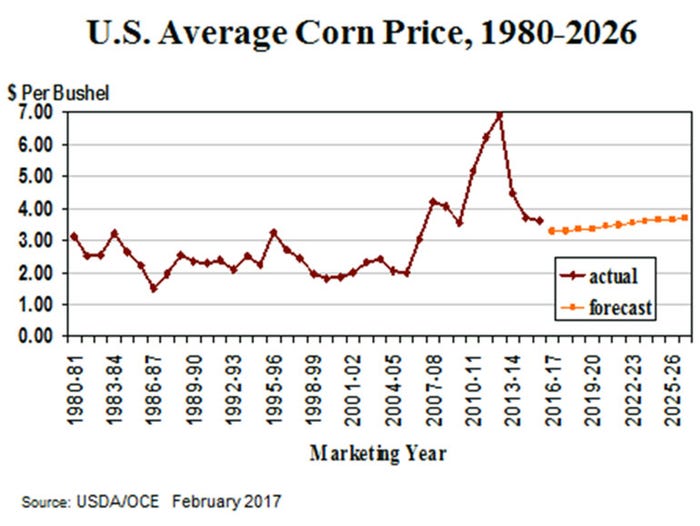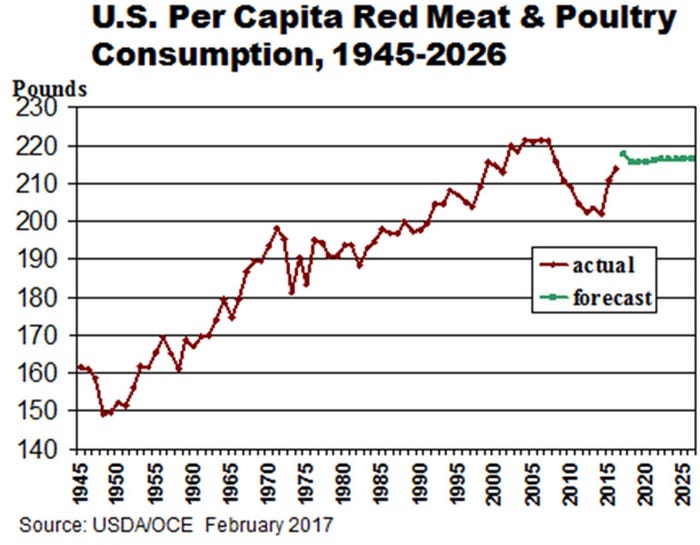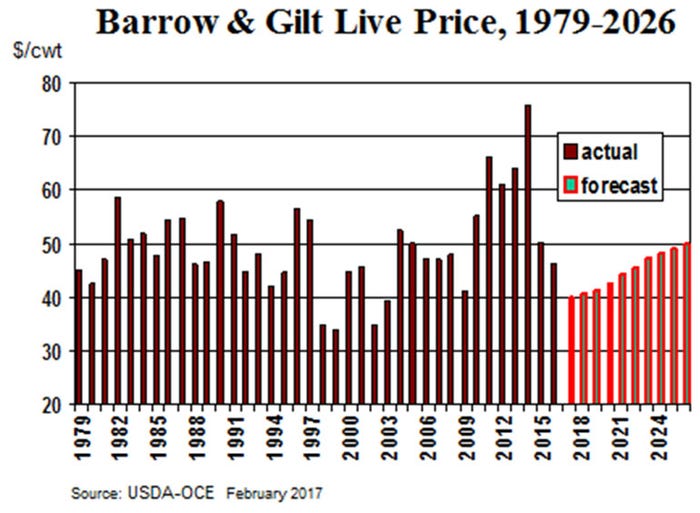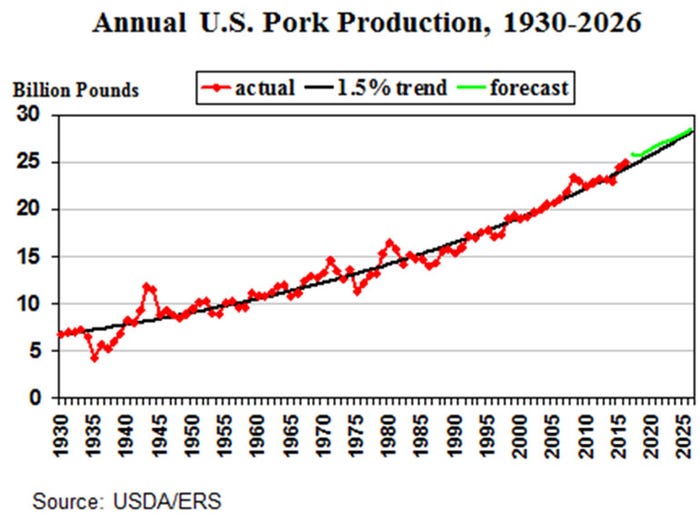Are 2016 commodity prices the new normal?
Over the coming 10 years, USDA expects U.S. pork production to increase by 3.497 billion pounds (14.0%); domestic pork consumption to increase by 2.276 billion pounds (10.9%) and pork exports to increase by 1.279 billion pounds (24.7%).

Each February, USDA updates their 10-year price and production forecasts. USDA’s latest forecasts paint a much more stable picture for prices than what farmers have dealt with over the last 10 years. The last decade was one of great volatility for U.S. farm commodities. For corn, soybeans, wheat, hogs, cattle and milk, the high-price year in the last decade had prices that averaged more than 80% higher than the low-price year.
The farm price of corn averaged $3.39 per bushel in 2007 and $6.67 in 2012. Soybeans averaged $7.74 per bushel in 2007 and $14.07 per bushel in 2013. Wheat averaged $4.11 per bushel in 2016 and $8.02 in 2008. Slaughter hogs averaged $41.24 per hundredweight in 2009 and $76.04 per hundredweight in 2014. Fed cattle averaged $83.25 per hundredweight in 2009 and $154.40 per hundredweight in 2014. Class III milk averaged $11.36 per hundredweight in 2009 and $22.34 per hundredweight in 2014.
For the upcoming decade, the USDA’s price forecast for the high year for each of these commodities is no more than 25% above the low year’s price forecast.
In 2016 the farm price of corn averaged $3.48 per bushel. USDA is predicting each of the next 10 marketing years will see corn prices average between $3.30 and $3.70 per bushel.

Some of the stability in USDA’s price forecasts is an illusion, since USDA predicts not only the price but also the year when it will occur. A challenge in doing long-term crop forecasts is what to do about adverse weather. USDA knows a summer drought will boost corn prices, and they know a drought is likely to occur sometime in the next 10 years, but they don’t know when. Thus, their corn price forecast includes no high-price year driven by bad weather.
If corn prices hold steady, other commodities are likely to be less volatile, too. Corn is the key U.S. farm commodity. It is grown on more acres than any other annual crop and it is the dominant feed for livestock. When corn prices are high, corn attracts acres away from other major farm crops. Also, high corn prices slow or stop growth in livestock and poultry production. The reverse happens during periods of low corn prices.
USDA is predicting that the number of acres planted to corn will slowly decline under pressure from continuing low prices. Yield per acre is forecast to increase two bushels per year, causing annual corn production to increase only slightly. Their forecast does not include a year with corn production above last year’s record of 15.1 billion bushels.
Red meat and poultry consumption increased from a bit under 150 pounds per person in the late-1940s to a bit over 220 pounds per person in 2004-07. Only modest change is expected in the next 10 years. Per capita meat consumption is forecast to increase by 2.2 pounds from 2016-26 with the increase composed of 1.5 pounds more pork, 0.6 pound more beef and 0.1 pound more of the other meats. USDA’s forecast for 2017-26 has no year with higher per capita meat consumption than their forecast for 2017.

One of the most surprising parts of USDA’s long-term forecast is what they are predicting for broilers. Per capita poultry consumption is forecasted to increase by only 0.3 pound in the next 10 years with the increase coming from more turkey consumption. Per capita chicken consumption is forecast to be the same in 2026 as it is today. Over the last 60 years, chicken consumption has increased by nearly 66 pounds per American. To see this long steady growth in chicken consumption come to an end is something the red meat industry has long anticipated.
Over the next decade, USDA is forecasting a 10% increase in broiler production, a 7.6% increase in consumption and a 21% increase in exports.
Last year’s base market hog price averaged $46.14 per hundredweight on a live weight basis. USDA’s long-term forecast has the coming 10 years with a low in base hog prices of $40 per hundredweight in 2017 and a high of $49.91 per hundredweight in 2026.

Over the coming 10 years, USDA expects U.S. pork production to increase by 3.497 billion pounds (14.0%). They are predicting domestic pork consumption will increase by 2.276 billion pounds (10.9%) and that pork exports will increase by 1.279 billion pounds (24.7%). They expect a 32 million-pound increase in annual pork imports (2.9%) in the next 10 years.
USDA’s projections have pork production increasing at an average annual rate of 1.3% per year. That is slightly slower than the long-term trend of 1.5% per year, but production is currently slightly above trend.

Since population growth (25.1 million over the next 10 years) is projected to average 0.75% per year while pork consumption increases by 1% per year, per capita pork consumption, by necessity, has to increase. By 2026 the average American is expected to consume 51.4 pounds of pork per year, the most since 2004. The increase in pork production is projected to be 75% faster than population growth.
Last year slaughter steer prices averaged $121.16 per hundredweight. USDA has the coming 10 years with a low in fed cattle prices of $104.52 per hundredweight in 2026 and a high of $118.57 per hundredweight in 2019.
USDA’s 10-year forecasts imply both feed costs and hog prices will resemble 2016 quite often over the next 10 years. Although that is a defensible forecast, it is more likely that unexpected events will make the future much more interesting than just a continuing rerun of 2016.
About the Author(s)
You May Also Like





